On May 6, 1998, Steve Jobs took the stage and announced the iMac G3, a consumer counterpart to the G3-powered PowerMac and PowerBook, the only remaining computers in Apple’s lineup after he had slashed all other machines, including the popular Performa line.
“The back of our computer,” he said, “looks better than the front of the other guys’. It looks like it’s from another planet. A good planet. A planet with better designers.”
August 1998: The Bondi-Colored Savior
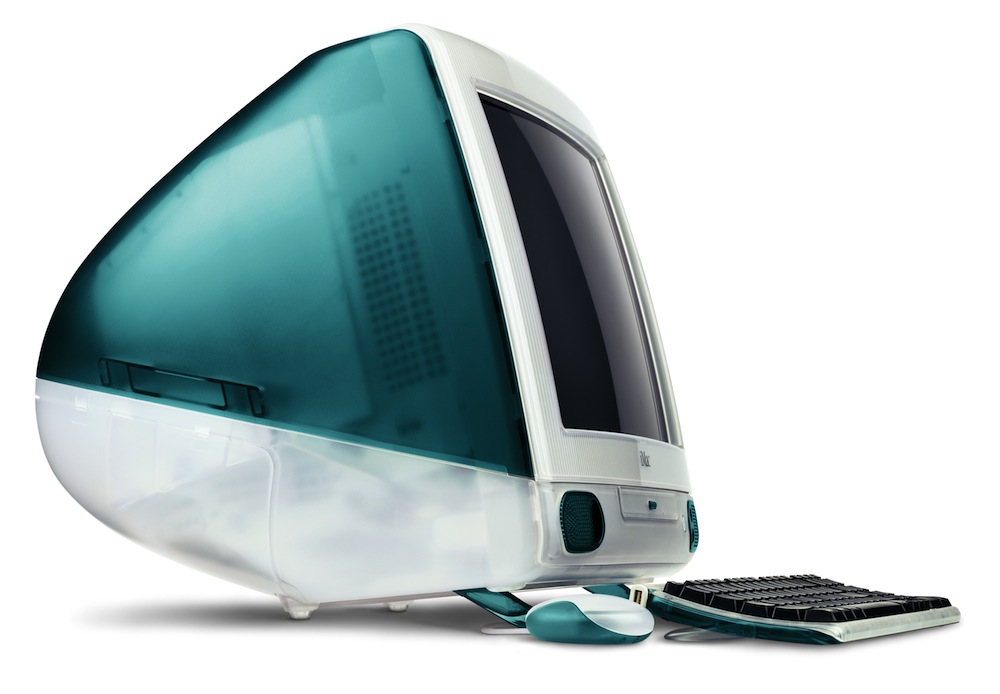
The original iMac was introduced in 1998. In typical Jobs style, the keynote was something to behold.
“iMac comes from the marriage of the excitement of the Internet with the simplicity of Macintosh,” he said. Internet usage was “the number one use” consumers wanted, and the iMac was built to make that easy.
The iMac started the “i” revolution. Jobs said the i stood for:
- internet
- individual
- instruct
- inform
- inspire
In addition to the consumer, Apple aimed the iMac at the education market, one of the company’s few remaining strongholds in the market at the time.
With the iMac, Apple returned to Jobs’ vision of an all-in-one computer, with all of the guts in the same case as the display. In a world of messy PCs, the iMac stood out as a simple, elegant computing solution.
While most of the computers at the time were beige boxes — including Apple’s other desktops — the iMac G3 was bondi blue, curvy and translucent.
The iMac G3 was built around its 1024×768, 15-inch CRT. The shape of the CRT defined the machine, with a slightly curved front.
The original iMac featured a 233 Mhz G3 processor, with a 512KB backside cache, coupled with 32 MB RAM, a 4 GB hard drive and a 24x tray-loading CD-ROM drive.
The big news with the original iMac, however, was the I/O. Apple stripped away all of its previously-used ports, including SCSI, ADB
Behind the door on the side, Apple had a 100 Mb Ethernet port, modem and up front an IR port.
…aaaand a pair of USB ports, which made the old-timers light their hairs on fire, but paved the way for easy, plug-n-play support for loads of peripherals like cameras, scanners, floppy drives and more.
January 1999: The Five Flavors
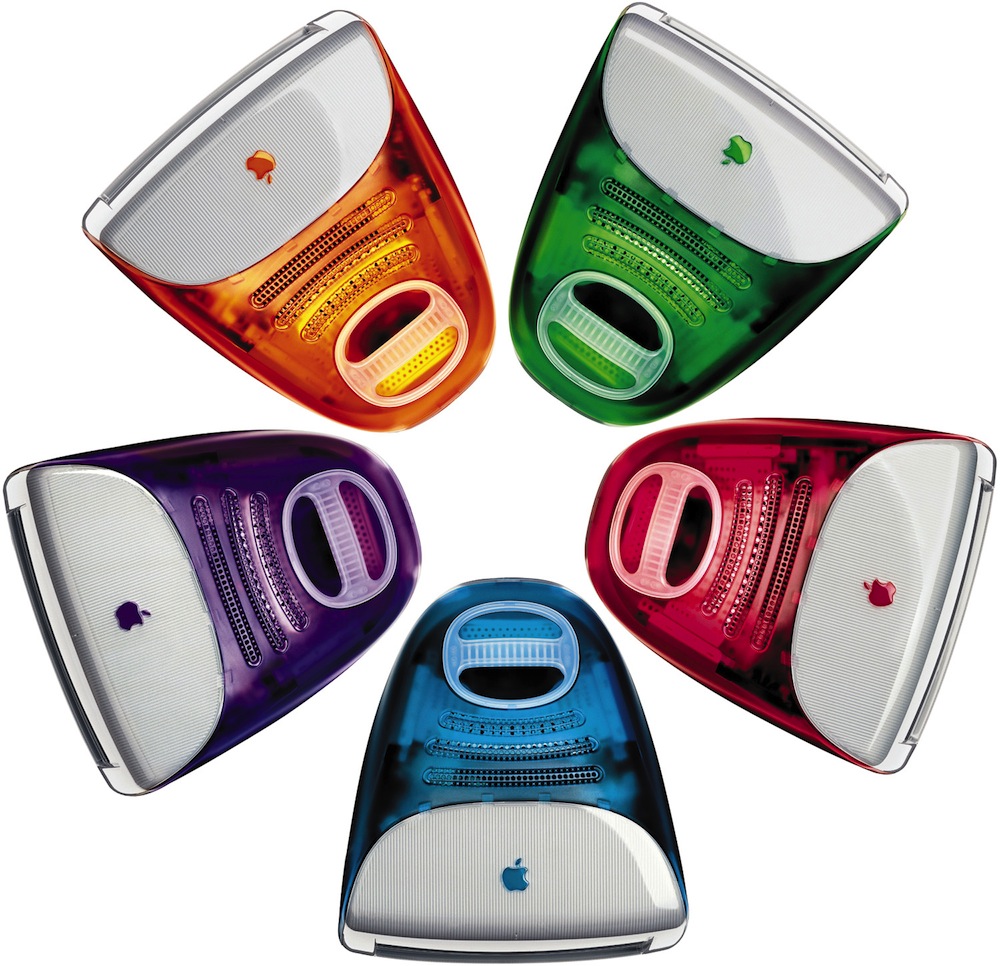
The original iMac shipped in August 1998. In January 1999, Apple offered the machine in five distinct colors. These machines shipped with a more powerful 266 Mhz G3 processor, coupled with a ATI Rage Pro Turbo graphics card with 6 MB SGRAM. The IR port was scrapped, as was the internal mezzanine slot.
The colors were as follows, clockwise:
- Tangerine
- Lime
- Strawberry
- Blueberry
- Grape
These machines followed a mostly-silent “Rev. B” upgrade that happened just two months after the initial iMacs shipped. This upgrade featured Mac OS 8.5 and a ATI Rage Pro graphics card with 6 MB of SGRAM.
The Five Flavor iMacs sold for $100 less than Rev. A & B machines, at just $1199.
The Five Flavors got a spec bump to 333 Mhz in April 1999, and were replaced in October 1999, when Apple released the iMac (Slot Loading) line.
October 1999: Slot-Loading iMacs
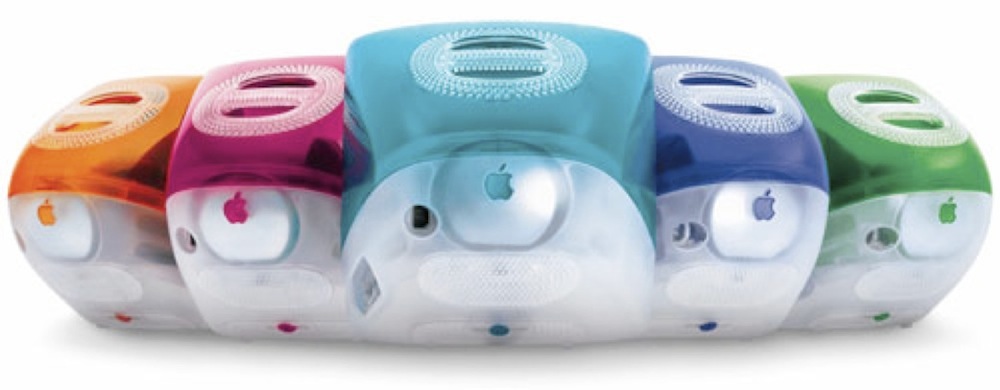
In October 1999, Apple started shipping a slot-loading optical drive in the iMac, marking the start of the second batch of updates to the machine. These machines shipped with 8 MB of video RAM, thanks to a new ATI Rage 128 VR card. The Slot-Loading line also shipped with a base of 64 MB RAM, up for the first time since the original iMac (with a maximum capacity of 1 GB of RAM).
With this update, Apple split out the line in to “Good, Better and Best” models.
At the base, a 350 Mhz model sold at the elusive $999 price point, and was available only in Blueberry.
The 400 Mhz models included FireWire support, and wore the “DV” badge. These machines shipped in Blueberry, Grape, Strawberry, Tangerine and Lime, as the “Five Flavor” iMacs before them.
The “DV SE” was the same machine, but in Graphite, which, in my opinion, is the best-looking of all the iMac colors.
All of the slot-loading iMacs weigh in at 34.7 pounds / 15.7 kg, with dimensions of 15.0 x 15.0 x 17.1 inches / 38,1 x 38,1 x 43,5 cm.
The previous tray-loading iMacs were slightly larger at 38.1 pounds / 17.2 kg and 15.8 x 15.2 x 17.6 inches / 40,1 x 38,6 x 44,7 cm.
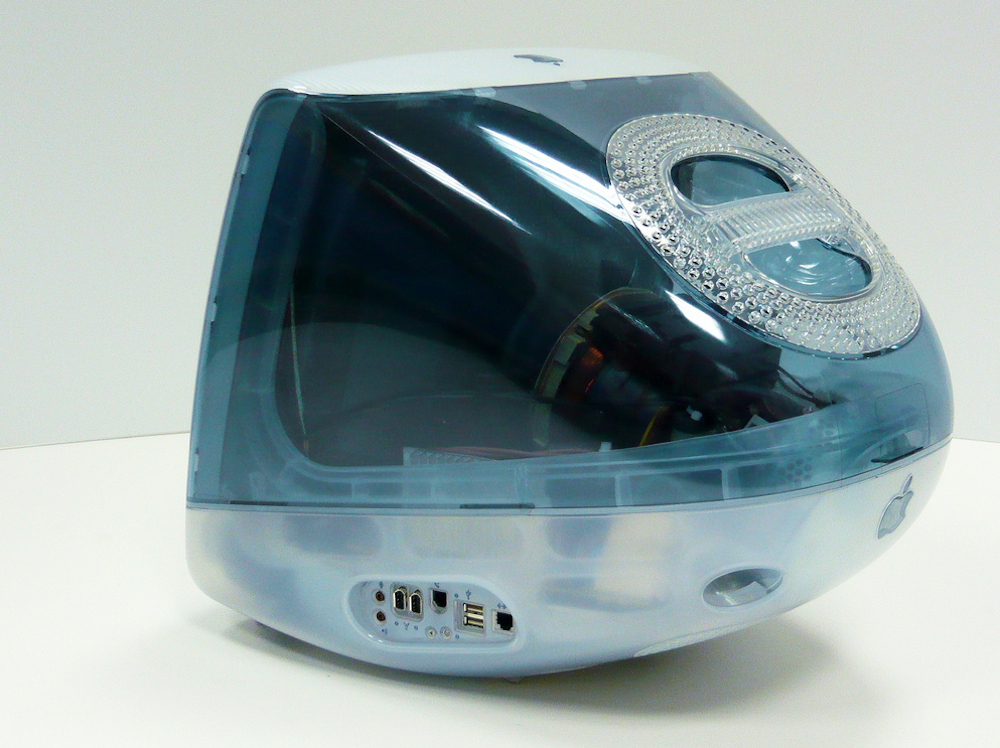
July 2000: Summer 2000 iMacs

In July 2000, Apple revved the iMac G3 line once again. These machines got new processor and hard drive options, and added support for Apple’s new AirPort cards. These iMacs required Mac OS 9.0.4, and support up to OS X 10.4 Tiger, except for the base model, due to its lack of FireWire 400 ports.
Gone were the Five Flavor colors.
At an all new $799 level, Apple had an all-new Indigo iMac running at 350 Mhz, with no FireWire and no AirPort support.
At 400 Mhz and $999, the iMac DV (Summer 2000) was available in Indigo and Ruby. These were the first iMacs to ship with Apple’s Pro Keyboard and Mouse, in black.
The iMac DV+ (Summer 2000) was the only iMac to ship at 450 MHz. It was available in Indigo, Ruby, and Sage. A slot-loading DVD-ROM was standard.
This generation of iMac also had a “DV SE” option, in the previously-used Graphite, as well as a new Snow color.
February 2001: Early 2001 iMacs
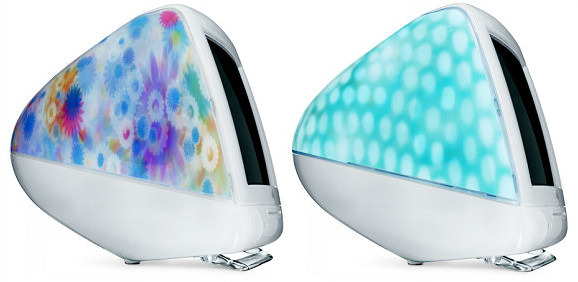
Welcome to what I call the “WTF Phase” of the iMac G3.
With this generation, all models gained FireWire 400 ports. Apple dropped Sage and Ruby in favor of “Blue Dalmatian” and “Flower Power”, two new patterns that were molded into the iMac’s case using a technique which took Apple 18 months to perfect.
Bonkers.
The low-end option was basically a “DV (Summer 2000) with a 400 Mhz processor at $899.
On the high-end, the new iMac picked up a CD-RW drive, leading to the “Rip. Mix. Burn.” campaign. These machines came with 20 GB hard drives and 500 Mhz G3 processors, as well as new video cards. These machines required OS 9.1
July 2001: Summer 2001 iMacs
In July 2001, Apple revved the iMac G3 for the last time.
Thankfully, Flower Power and Dalmatian didn’t make it past that single generation.
At the low end, running at 500 Mhz, Apple had an iMac in Indigo and Snow, with and ATI Rage 128 Ultra (AGP 2X) graphics card with 16 MB of VRAM, an an optional CD-RW drive. This machine sold for $999, an increase over previous low-end machines.
At 600 Mhz, the middle of the road iMac came with a 40 GB hard drive, CD-RW drive and the same video card as the low-end model. It sold in Graphite and Snow for $1299.
A 700 Mhz model was also for sale for a short time, making it the fastest CRT-based iMac of all time. In Graphite and Snow, it came with a 60 GB hard drive, but otherwise was the same as the mid-range model. This machine came with Mac OS 9.1 and Mac OS X 10.0.4, the only original iMac G3 to come with OS X.
The Final Chapter
In January 2002, with the release of the iMac G4, Apple re-arranged the iMac G3 line, keeping it for sale for a short time.
The low-end $799 model had its RAM bumped to 128 MB, and shipped with Mac OS X 10.2 as the default OS.
The G3/600 saw a price drop to $999.
The G3/700 was discontinued.
Conclusion
It’s hard to overstate the importance of the iMac G3. The iMac G3 ushered Apple in to the future, and on its translucent back, Steve Jobs rebuilt the company. While it was already under early development when Jobs returned to Apple, he took the project and made it the single machine he would re-launch the Macintosh family with. Before the iMac G3, Apple had numerous, conflicting product lines, and afterwards, just a handful of complementary ones.

Image via Wikipedia
Update:
Years after this blog post went up, I did a lot more with the iMac G3 than just write about it.